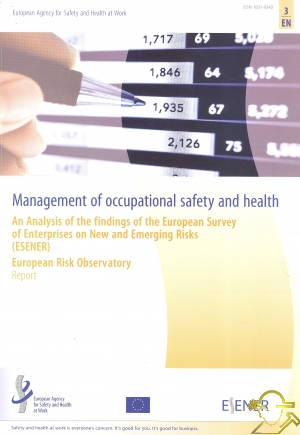Management of the Occupational Safety and Health 3/EN
İÇİNDEKİLERForewordAbbreviations and acronyms .Executive summary 1.Introduction 1.1.Description of ESENER 1.2.The aim of this report 2.Understanding the importance of the management of occupational safety and health 2.1.Management of occupational safety and health 2.1.1.Work-related risks to health and safety 2.1.2.Costs of poor health and safety at work 2.1.3.European action to tackle health and safety risks at work 2.1.4.More recent approaches to occupational safety and health management 2.1.5.The effectiveness of occupational safety and health management 2.2.Occupational safety and health management systems 2.2.1.Characteristics of occupational safety and health management systems 2.2.2.Mandatory and voluntary occupational safety and health management systems 2.2.3.Effectiveness of voluntary and mandatory occupational safety and health management systems 2.3.Factors associated with the effectiveness of occupational safety and health management systems 2.3.1.Cultural, managerial, and operational factors and performance of occupational safety and health management systems 2.3.2.Barriers to effective occupational safety and health management systems 2.3.3.Enterprise characteristics and occupational safety and health management systems 2.4.Summary 3.Towards a conceptual framework for managing occupational safety and health 3.1.A conceptual framework for occupational safety and health management 3.2.The conceptual framework and the empirical analysis of the ESENER data 3.3.Summary 4.Analysing the ESENER data on managing occupational safety and health 4.1.The empirical approach 4.1.1.The conceptual framework and empirical analysis 4.1.2.An index of occupational safety and health management 4.2.Characteristics of the establishment and their relationship to the occupational safety and health index 4.2.1.Country context, size, industry and the management of occupational safety and health 4.2.2. The size of the establishment and occupational safety and health management 4.2.3.Industries and occupational safety and health management 4.2.4.Reporting of aspects of occupational safety and healthmanagement and country contex 4.2.5.Independent establishments relative to those part of a larger establishment 4.2.6.Private establishments and occupational safety and health management measures 4.2.7.Demographics of establishments and reporting of occupational safety and health management measures 4.2.8.Looking at combinations of factors 4.2.9.Looking in more detail at components of the index 4.3.Additional findings 4.3.1.The management of occupational safety and health compared to the management of psychosocial risks 4.3.2.The employee's and manager's perspectives in ESENER 4.4.Summary 5.Discussion of what the survey can tell us 5.1.Inherent limitations of the survey 5.1.1.Weaknesses common to surveys like ESENER and the empirical undertaken 5.1.2.The coverage in the survey of questions on the management of OSH 5.1.3.Outcome information in ESENER 5.1.4.ESENER and informal procedures and organisational culture 5.2.Summary 6.Towards policy recommendations 6.1.Main findings 6.1.1.The empirical analysis and the use of OSH management systems 6.1.2.Frequency of OSH practice 6.1.3.Size 6.1.4.Practice in industry 6.1.5.The country context 6.1.6.Other variables 6.1.7.An index for managing occupational health and safety and autcomes in ESENER 6.1.8.ESENER and the perspectives of employee representatives and management 6.2. Summary 7.References    |



